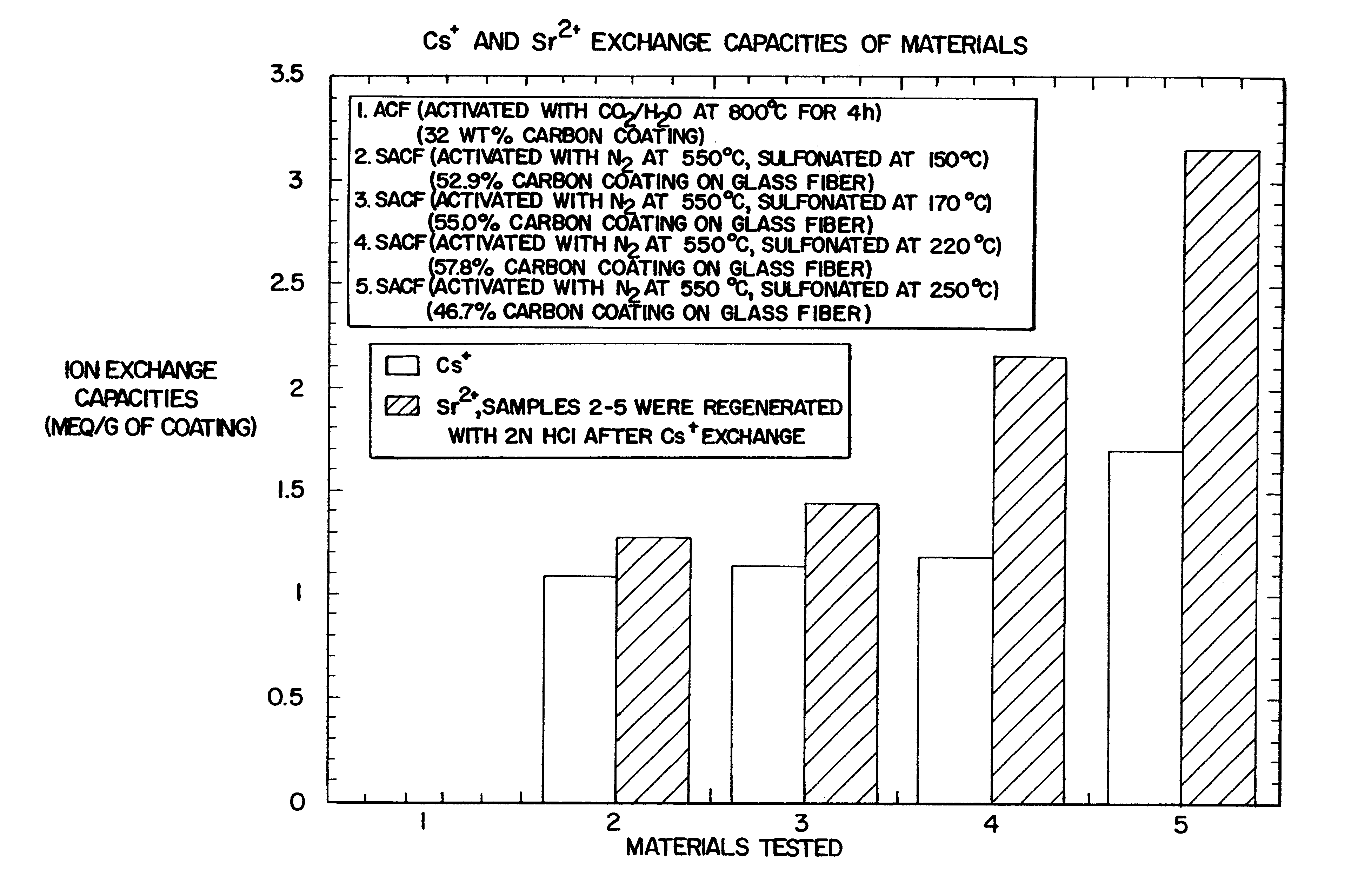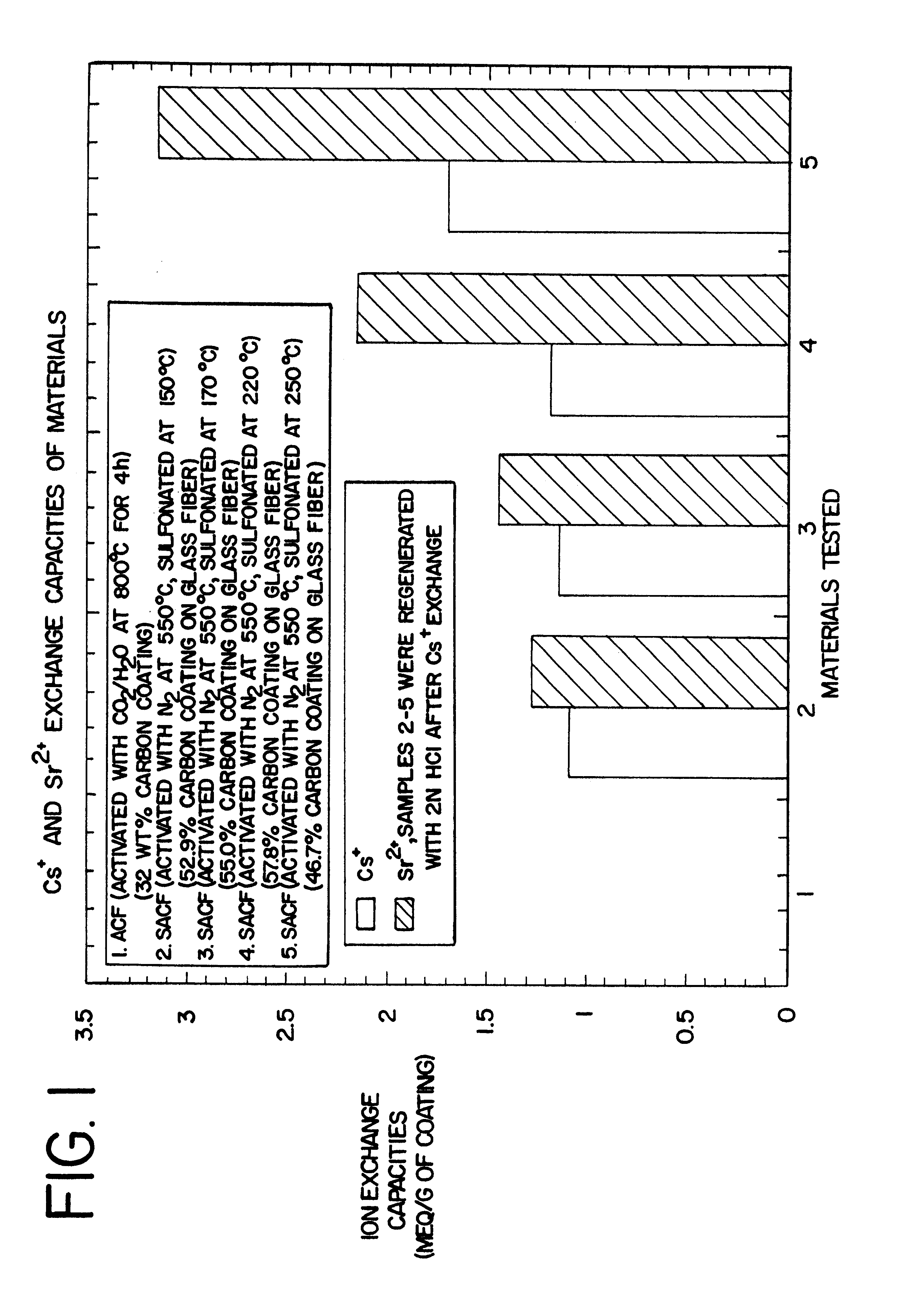Carbon fiber ion exchanger
a carbon fiber ion exchanger and carbon fiber technology, applied in the direction of cation exchanger materials, fibreboard, transportation and packaging, etc., can solve the problems of reducing limiting their cost-effectiveness, and so as to reduce the flexibility of carbon ion exchanger composite fibers, the effect of brittleness of carbon ion exchangers
- Summary
- Abstract
- Description
- Claims
- Application Information
AI Technical Summary
Benefits of technology
Problems solved by technology
Method used
Image
Examples
example 1
Preparation of Activated Carbon Fiber (ACF) Ion Exchangers
As a comparative example, the phenolic fiber Kynol.TM., was used as the precursor to produce activated carbon fibers. This fiber can be readily carbonized and activated to a wide range of surface areas.
I. Carbonization and Activation of Kynol.TM. Precursor
The phenolic fibers were heated under nitrogen flow at temperatures between 500.degree. C. and 600.degree. C., to produce carbon fibers with surface areas ranging from <1-600 m.sup.2 / g.
II. Functionalization
All carbonized fibers were functionalized in 150-ml concentrated sulfuric acid for 3.5 hours at a temperature of 220.degree. C. After activation, the samples were rinsed thoroughly in distilled water and soxhlet extracted with water for twelve hours to remove any residual acid. The samples were dried for twelve hours in air at a 130.degree. C. prior to capacity determinations.
III. Batch capacity experiments
The cation capacity was determined in a conventional manner. In a ...
example 2
Preparation of Ion Exchanging Activated Coatings Supported On Glass Fiber Substrates (Carbon Ion Exchanger Composite Fibers)
I. Preparation of Phenolic Coated Glass Fiber
25 g of novolac were mixed with 1.7 g hexamethylenetetramine, and then dissolved in 100 mL ethanol. Preweighed samples of non-woven glass fibers were dipped into the resin solution and cured in a tube furnace under argon at a flow rate of 130-200 mL / min. The coated fiberglass was heated in the furnace to 100.degree. C. for 20 minutes to remove the solvent. The coated fiberglass was then cured, first by heating the coated fiberglass to 150.degree. C. over 20 minutes followed by an additional 20 minutes. The resultant fiber has a 65 wt % resin coating.
II. Carbonization and Activation
The phenolic-coated glass fiber was heated under nitrogen flow at 550.degree. C. to produce the activated char on glass fibers. The coating yield of this system was 85%.
III. Functionalization
The carbonized fiber was functionalized in 150-ml...
example 3
Preparation of Ion Exchanging Activated Coatings Supported On Glass Fiber Substrates Using Chemical Activation Techniques
I. Preparation of Phenolic Coated Glass Fiber
15 g of novolac were mixed with 1 g hexamethylenetetramine and 13.95 g ZnCl.sub.2, and then dissolved in 100 mL ethanol. Preweighed samples of non-woven glass fibers were dipped into the resin solution and cured in a tube furnace under argon at a flow rate of 130-200 mL / min. The coated fiberglass was heated in the furnace to 100.degree. C. for 20 minutes to remove the solvent. The coated fiberglass was then cured, first by heating the coated fiberglass to 150.degree. C. over 20 minutes followed by an additional 20 minutes. The resultant fiber has a 65 wt % resin coating.
II. Carbonization and Activation
The phenolic-coated glass fiber was heated under nitrogen flow at 350.degree. C. to produce an activated coating on glass fibers. The coating yield of this system was 95%. The fiber was washed with distilled water followed...
PUM
| Property | Measurement | Unit |
|---|---|---|
| pH | aaaaa | aaaaa |
| length | aaaaa | aaaaa |
| diameter | aaaaa | aaaaa |
Abstract
Description
Claims
Application Information
 Login to View More
Login to View More - R&D
- Intellectual Property
- Life Sciences
- Materials
- Tech Scout
- Unparalleled Data Quality
- Higher Quality Content
- 60% Fewer Hallucinations
Browse by: Latest US Patents, China's latest patents, Technical Efficacy Thesaurus, Application Domain, Technology Topic, Popular Technical Reports.
© 2025 PatSnap. All rights reserved.Legal|Privacy policy|Modern Slavery Act Transparency Statement|Sitemap|About US| Contact US: help@patsnap.com


